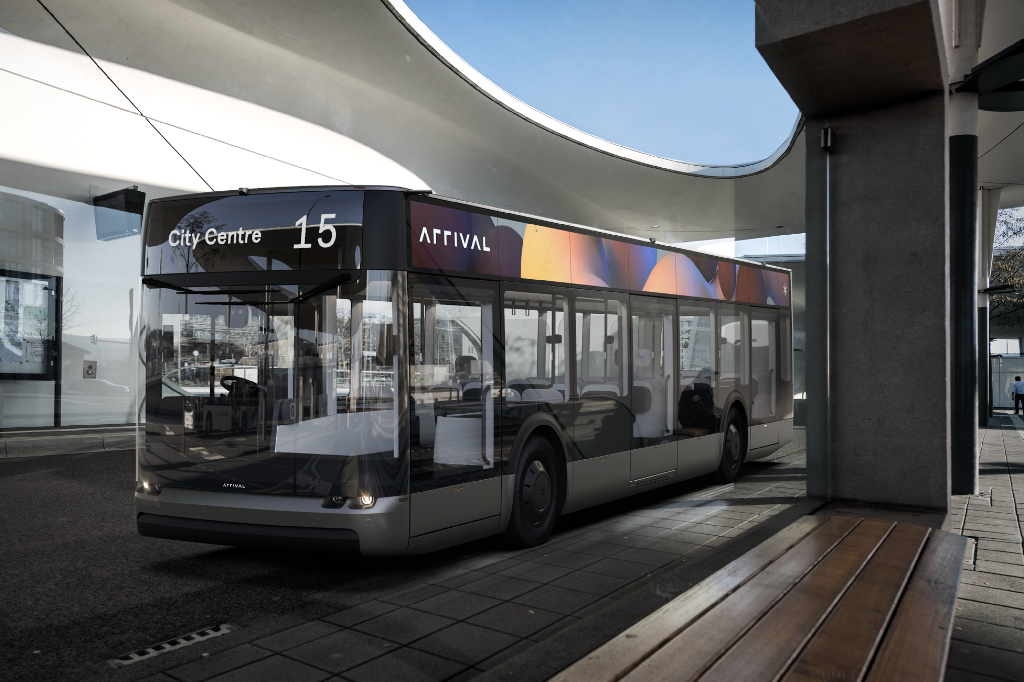The Arrival Bus — Changing public transport for everyone
by Alex Jarvis
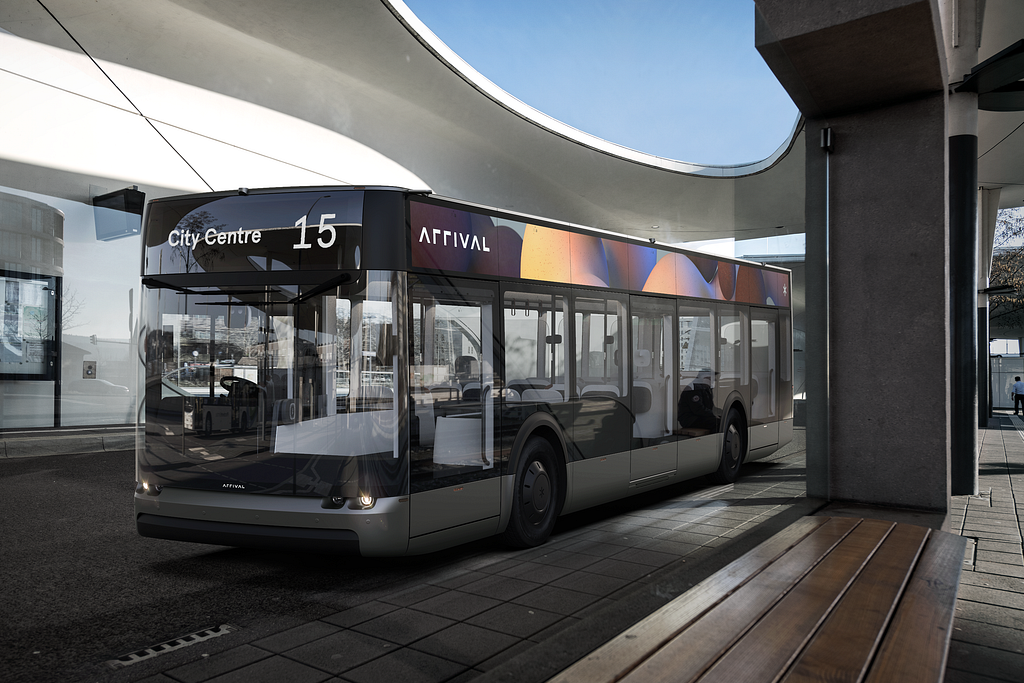
A bus for everyone
We’ve made a bus.
While our towns, cities, villages and the ways we move around them have changed drastically over the last few years, bus travel has stayed more or less the same for many decades. It’s often seen as a necessity rather than a desire, function over form, an unremarkable experience rather than an unforgettable one. Public transport in general is often thought of as a substandard alternative to a private vehicle. We don’t feel this is right — there’s no reason why a public bus shouldn’t be as comfortable and as enjoyable as a modern privately owned vehicle.
In a post-Covid world, public transport will feel like a strange place. But with major cities starting to prioritise space for pedestrians, cyclists and buses, mass transportation will continue to be an essential part of city infrastructure. Cities like London have already replaced roads with bus only lanes. With municipalities all over the world striving to ultimately ban private vehicles from city centres, we feel a duty to ensure that a bus is a pleasant, healthy place to be.
The Arrival Bus isn’t just designed for passengers. It’s designed for drivers, fleet operators, cleaning staff, maintenance staff, city managers, pedestrians, cyclists and city residents too. It’s the second vehicle we’ve announced and the first time we’ve mentioned the ecosystem that will be powering everything we make. It’s made possible by our in house technologies, and designed experience first, for everyone.
In the words of our CXO, Kwame Nyanning: “Every single touchpoint with these vehicles is an opportunity to improve someone’s moment.”
This is not an exhaustive list of every feature of our bus, rather an introduction to some of the ways we’re hoping we can make mobility a better experience for all.
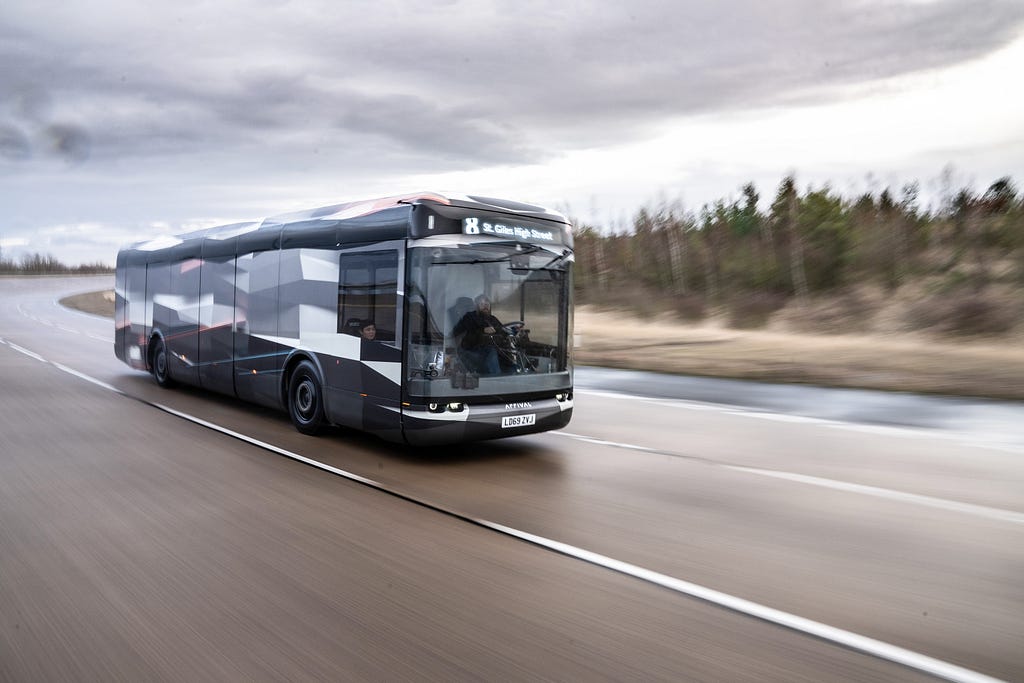
A bus for passengers
Very few of us could say that we’ve had a positive experience as a bus passenger. Even on a familiar route, a bus ride can be a hectic and overwhelming experience, let alone when you’re going somewhere new. Bus transport is such a large part of so many of our daily routines, it deserves to be a pleasure rather than a chore. Rather than focusing on just designing a better space inside, we’ve tried to design an overall better experience, all the way from discovery to boarding, alighting and the onward journey.
While detailed transit information such as capacity or timetabling is starting to become more readily accessible, it often relies on the use of a smartphone or connected infrastructure such as a bus stop. As the Arrival Bus approaches a stop, the wrap-around external screens can display route or vehicle specific information — available seating, free space inside or traffic and delays en route. It’s accessible whether you own a connected device or not.
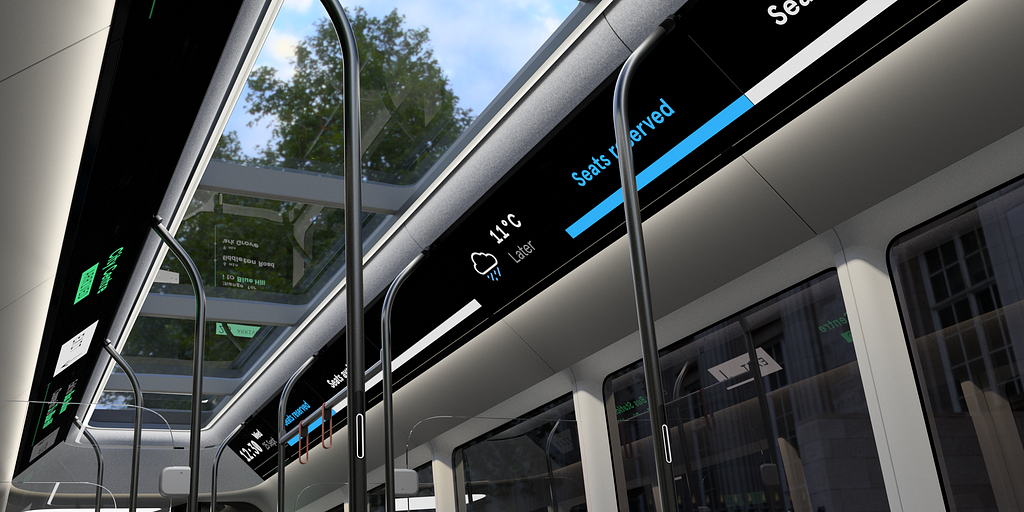
When the Bus is ready to board, we can use the screens to guide passengers to free seats, or to manage passenger flow on and off the vehicle by designating entrance and exit doors. On the journey we can show route status, traffic and weather information. When alighting, we can use the screens to direct passengers to points of interest or transit links.
Unlike some trains or tubes, many buses require users to press a stop button to indicate to the driver that they need to get off. In the immediate post-Covid world, this isn’t ideal. We’ve redesigned the bus bell push to allow for contactless interaction — a wave over the surface will request a stop. Integrated lighting within the bell push unit gives a status light to display if a stop has been requested, and when a bus has reached a stop. We also have the ability to let a passenger request a stop remotely from a personal mobile device, without having to touch a shared surface.
The sound design of the Arrival Bus has been crafted alongside the digital and physical interactions and industrial design to create clarity and enhance usability — treated as an integral part of the overall experience rather than an afterthought. Bespoke audio notifications for the driver and passengers and a subtle soundscape inside the cabin help to make the bus a calm, serene place to spend time.
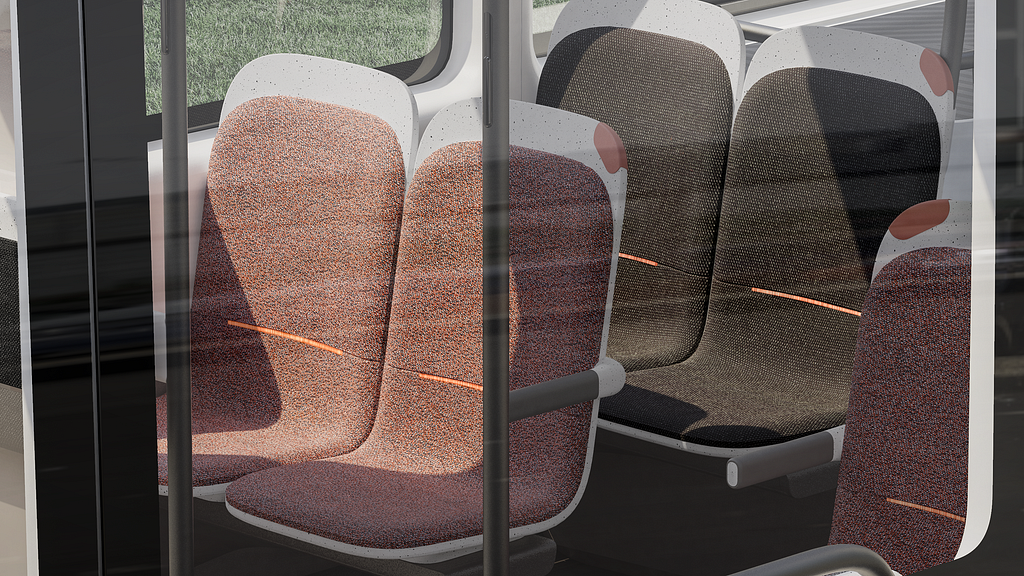
A bus for drivers
A bus cabin is the drivers’ office. It should be somewhere that they feel happy spending a large part of their day, a space that they feel proud of, and a space that, more than anything, allows them to focus on doing their job well. It should be comfortable, clean and safe.
We spent time speaking with bus drivers to help understand their frustrations and concerns with their working environment. We found that cramped cabins with an overwhelming number of mostly unused controls and a lack of functional space were a problem. Often cabins felt unclean and unsanitary, with some drivers taking a few minutes before their shift to tidy up to make the space usable. All bus drivers deserve a space that always feels like their own — a serene space in the middle of a chaotic, busy transport system.
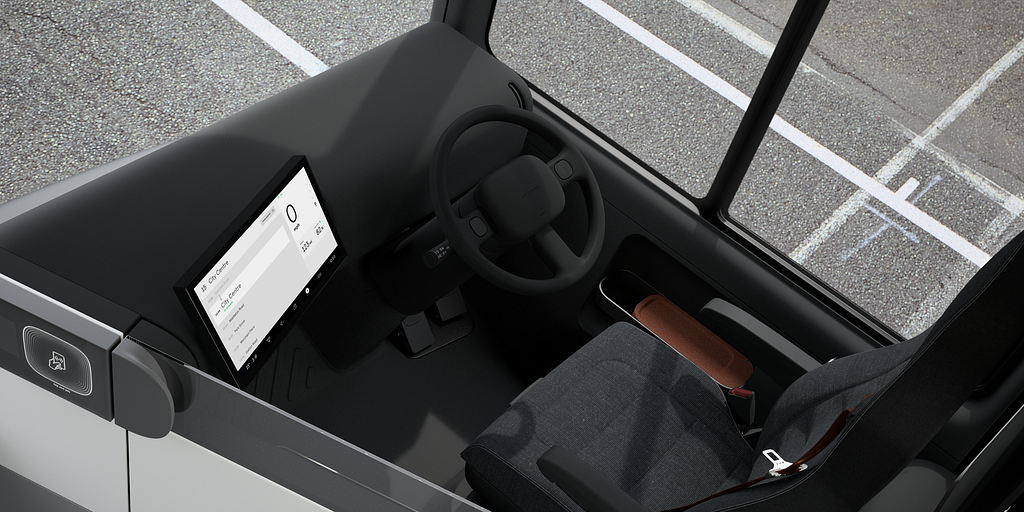
The first thing you’ll notice about the Arrival Bus cabin is that there isn’t a lot in there. We consolidated physical controls and regular points of contact that were previously spread around the cabin to a single touch screen, to reduce cognitive load and let the driver focus on driving and serving passengers. Some screen based controls are displayed based on vehicle context — hidden when not required, and brought to the surface when needed. We’ve included usable storage for bags and personal items, and made the cabin easier to clean — with just a few surfaces requiring a wipe over.
Behind the scenes are a suite of software tools and a network of connected functionality that support both the driver and the operational staff to be able to run a more efficient service. We don’t just want to give drivers a better bus, we want to give them a vehicle they feel proud to drive and that enables them to excel at their job, ultimately providing a better experience for their passengers.
A bus for operators and support staff
Public transport all over the world handles thousands (sometimes hundreds of thousands) of people per day. In such a fast moving environment these shared vehicles and spaces require regular cleaning and maintenance to function safely and provide a clean environment for passengers. Support staff, specifically cleaning staff, are essential to this operation.
Time is critical during the cleaning process. At the end of a shift a depot team needs to turn around a large number of buses in a small amount of time, getting them ready for the next service. The Arrival Bus has been designed with existing cleaning procedures in mind, but with the aim of maximising efficiency.
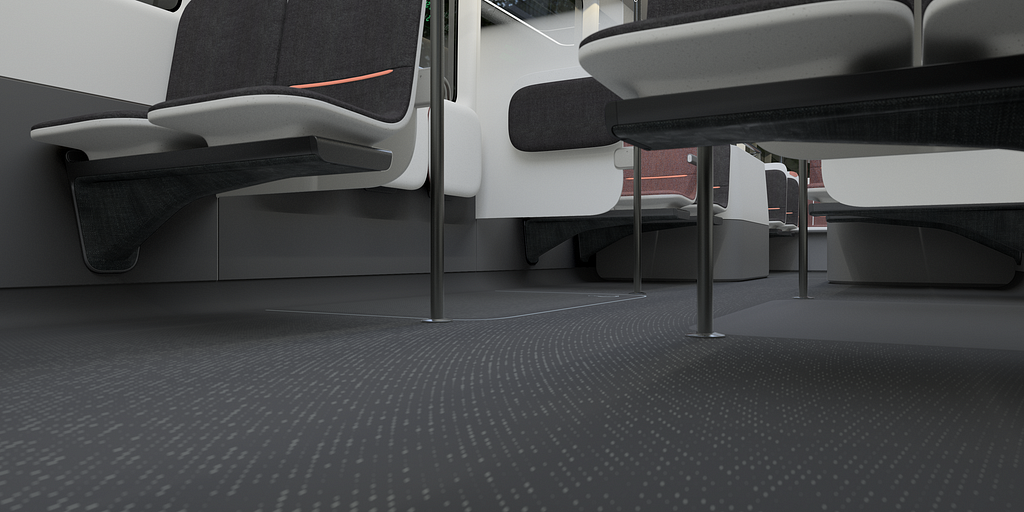
The Bus is built on our skateboard platform, meaning a completely flat floor from front to back. Unbroken, curved edges between the floor and walls ensure that dust, dirt and spillages don’t get trapped in hard to reach areas. On top of this, cantilevered seats attached only to the vehicle side wall mean that cleaning staff are able to get mops and brooms underneath easily without any obstructions. The seating is modular to allow an operator to install different seating configurations relatively easily, should the need arise.
Onboard connectivity gives fleet managers and depot staff full oversight over vehicle data, enabling them to maintain efficient operations and minimise service downtime — essential for a service that both drivers and passengers feel they can trust.
A bus for the city
Buses are often part of the fundamental architecture of a village, town or city. Clocking up hundreds (if not thousands) of miles a day, in some way interacting with not just passengers but with cyclists, pedestrians, taxis, other buses, vans, lorries and private vehicles.
But for anything other than a passenger, the value of a bus can be negligible. Confrontations between Buses and other road users are commonplace and accidents are not only detrimental to the relationship a passenger has with a bus service but also a strain on operational efficiency and customer perception for the service operator.
We want to use a combination of data from our vehicles and municipality data to create a vehicle that isn’t just a better bus, but a valuable contributor to the way people live, helping a local community to function more efficiently.
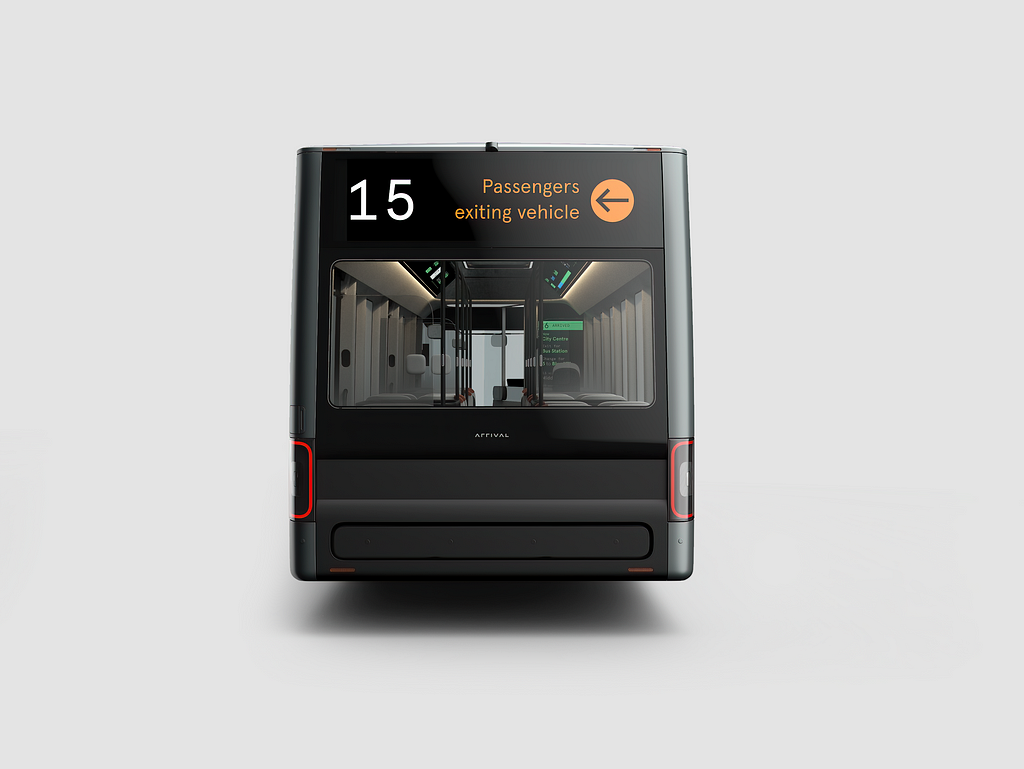
As a cyclist approaches a parked bus, we can use our external screens to make them aware that passengers are about to leave the vehicle. We can tell other drivers that it’s safe to overtake a bus that’s sat at a stop, or we can let a queue of traffic know that a bus is about to pull away. We see the bus as a mediator, a mechanism that draws lines between previously unconnected actors in a complex town or city environment.
And of course, wide adaptation of electric vehicles is essential to try and maintain the dramatically lower levels of pollution we’ve experienced throughout the Covid-19 crisis. EVs of all kinds are no longer an option, but a necessity.
A bus for advertisers
Dynamic advertising is starting to become a common sight in transit hubs, with train and tube stations starting to replace static poster advertisements for remotely updated digital signage. Advertising on public transportation, however, is mostly still a single piece of printed content manually placed into a holder.
From morning commuters to school kids and the elderly, the demographics of a bus passenger vary greatly throughout the day. A static advert will have a limited amount of appeal and therefore a limited amount of impact or engagement. The amount of pedestrians engaging with external bus advertising across numerous areas of a municipality throughout a day add to the demographic complexity.
Our internal and external screens can allow full colour and full motion advertising content, legislation permitting. Using location data, we have the potential to serve advertisements based on the location of the bus, an example of this could be hyperlocal community messaging. We can sync advertising between screens, or have complementary content on different screens. We can scale the adverts to fill all of the screen, or some of the screen.
Above all of this, we want our bus to be respectful of its environment. We can use vehicle location data and the time of day to automatically dim screen content. Using vehicle speed, and following local legislation, we can switch between static and dynamic content, to minimise the impact of the screens on the locality.
We’re really excited about the possibilities both for advertisers and passengers alike.
A more accessible, inclusive bus
We know that public transport can be a daunting experience for many. By definition, public transport should be a democratised method of travelling around a municipality. It should be a method of transport that everyone feels they’re able to use comfortably and safely. Unfortunately, this is quite often not the case.
Connectivity not just between vehicles, but between vehicles, municipalities and personal electronic devices can allow us to prepare a driver and a vehicle for the needs of a priority passenger way ahead of time. We can keep the user updated through their own mobile device and guide them throughout their journey. We can make other passengers aware of the needs of priority customers — for example, making sure that seating space is clear ahead of time using the internal and external screens.
We hope that our bus can act as a facilitator to open up a method of efficient, considerate transit for everyone.
Which brings me on to the final point.
The Bus as a citizen
The announcement of the Arrival Bus is the start of a wider story for us. A bus as a citizen implies that it isn’t just a metal tube that transports people from one location to another — it’s an inhabitant of the place that it serves. It uses data to provide meaningful information to everyone around it.
A human citizen provides value to the place they live. Our bus is a method of transporting people around a city, town or village, but it is also a valuable member of society — an intelligent device that collects and distributes data, information and services to drivers, passengers, operators and inhabitants. As well of course, as being a better bus.
We’re excited to show the Arrival Bus to the world and even more excited to talk about the experience it delivers. We hope that as potential passengers, drivers, support staff and citizens, you’re just as excited to be able to experience one.
— — — — —
Alex Jarvis is Head of Product Experience at Arrival. For more information on Arrival visit http://arriv.al/Medium.
The Arrival Bus — Changing public transport for everyone was originally published in Arrival on Medium, where people are continuing the conversation by highlighting and responding to this story.
